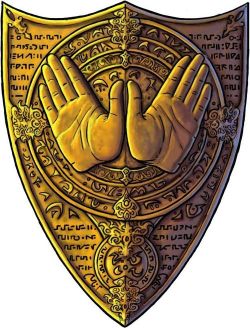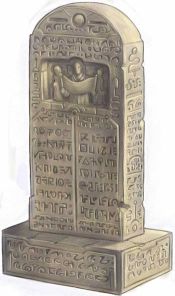« Rahadoum » : différence entre les versions
Page créée avec « {{Nation | image = 250px|Rahadoum | name = Rahadoum | titles = The Kingdom of Man | alignment =... » |
|||
| (Une version intermédiaire par le même utilisateur non affichée) | |||
| Ligne 1 : | Ligne 1 : | ||
{{Nation | {{Nation | ||
| image = [[Image: | | image = [[Image:Rahadoum symbol.jpg|250px|Rahadoum]] | ||
| name = Rahadoum | | name = Rahadoum | ||
| titles = The Kingdom of Man | | titles = The Kingdom of Man | ||
| Ligne 100 : | Ligne 100 : | ||
* [[Tomb of Emperors]] | * [[Tomb of Emperors]] | ||
= References = | |||
[[Category:Nations du Garund]] | |||
[[Category:Nations]] | |||
[[Category:Rahadoum| ]] | [[Category:Rahadoum| ]] | ||
Dernière version du 10 juin 2024 à 19:41
| Rahadoum | |

| |
| Nation | |
| Titre | The Kingdom of Man |
| Pays: | {{{land}}} |
| Alignement | Lawful neutral |
| Capitale | Azir |
| Dirigeant | Malduoni, Keeper of the First Law |
| Gouvernement | Standard (Council of Elders) |
| natives | Rahadoumi |
| adjective | Rahadoumi |
| Languages | Common, Osiriani |
| religions | None (atheism) |
| regionmap | |
| source | {{{source}}} |
The nation of Rahadoum (pronounced rah-ha-DOOM)[1] in northwestern Garund is unusual in that it is the only nation known to have forbidden the practice of any and all religions.[2]
History
The region now known as Rahadoum was the site of the first human kingdom to establish itself after the devastation of Earthfall. The Jistka Imperium was formed in -4120 AR and soon came to dominate northern Garund and even some neighbouring areas of Avistan.
Eventually the Imperium was defeated by the forces of ancient Osirion and their desert nomad allies of the Tekritanin League, and the land gradually came under the sway of Osirion.[3]
Ancient Osirion itself eventually went into decline, and the region split into a number of different city states. These states came to revere Nethys and Norgorber.
During the third millennium of the Age of Enthronement the faith of Sarenrae began to spread across northern Garund. When it arrived in this north western corner it came into conflict with the two previously established religions. The result was the Oath Wars, a long and bloody religious conflict that inflicted untold devastation on the region.[2]
Then, in 2555 AR, the folk of Azir put an end to the religious conflict in their city by the simple expedient of burning down all the temples and banishing all clerics from their territory. A new philosophy was introduced to replace religion; it came to be known as the Laws of Man. The Laws of Man spread quickly across the region. The other city states likewise abolished religion, swore to uphold the new Laws, and were welcomed into what became the nation of Rahadoum.
Since then, all forms of religion remain banned in Rahadoum. This has brought peace from religious conflict, but a number of problems over the centuries has led to dark mutterings that the gods are punishing the people of Rahadoum for their impiety. Plague has broken out in Azir and Botosani three times in the last five hundred years, and the desert is threatening to devour the once lush city of Manaket.[4]
The country’s borders have remained stable ever since, apart from the loss of the northern province of Kharijite to Cheliax during the Everwar.[5]
Government

The Kingdom of Man is ruled by a council of elders comprised of representatives from every major settlement and nomadic group. Overseeing the council, the Keeper of the First Law is elected from within the council and serves for a five-year term. Keepers are rarely re-elected and the resulting lack of institutional memory leads other nations to see Rahadoum as somewhat fickle, often waiting out the terms of a Keeper they find difficult to deal with.
The current Keeper, Malduoni is an exception to this, as he is currently serving his second term of office.
The seat of government is Azir, the nation's largest city. The rulers and citizens of Rahadoum continue to follow the Laws of Man, written by Kalim Onaku in 2555 AR, which strictly prohibit religion of any kind within the borders of the land. The government's primary military and peacekeeping force, especially with respect to the quelling of religious cults, speech and paraphernalia, is the Pure Legion.[4]
Relations are poor with neighbouring Thuvia, due to that country’s large number of worshippers of Sarenrae (arguably the religion responsible for causing the Oath Wars). Relations with Osirion might be expected to be strained for the same reason, but in fact both nations see the benefits of being good neighbours to one another, and pragmatism has won out over religious differences.
To the south, Rahadoum has little interest in the wilds of the Mwangi Expanse, and its shipping suffers at the hands of Shackles pirates.
The country’s other neighbours—the hurricane-blasted Sodden Lands, devil-dominated Cheliax and the religious assassins of Mediogalti Island—are seen as a vindication of Rahadoum’s decision to ban religion.[4]
Religion
The primary tenet of rule in Rahadoum is the First Law, which prohibits religion in any form. Foreigners visiting the country must submit to a thorough search by the Pure Legion upon arrival in Rahadoum. Possession of contraband items such as holy symbols or religious artefacts carries heavy fines and potential exile, while preaching religious doctrine garners much harsher punishments, including imprisonment or worse. For all that, the black market does a thriving trade in divine magic items.[2]
Most faiths have a presence in the nation, but to date, no religion has managed to become powerful enough to pull the nation from its strict avoidance of the divine, and all worship is done in secret.[6]
Powerful extraplanar agents of the gods also sometimes use Rahadoum as a neutral area in which to deal with one another. Each side knows that the other has few resources here with which to carry out any treachery. There are a number of unexplained supernatural events in the country’s cities. In some cases these are caused by invisible conflicts between these extraplanar visitors.[4]
Trade
The country’s fine cloth, exotic produce, and gemstones are sought-after by foreign merchants,[7] who generally do not allow any religious scruples to get in the way of profits.[4] Other exports include salt, dates, tropical fruit (from the Eternal Oasis), base metals, tools, and herbal remedies.
Rahadoum’s trade is hindered by Cheliax’s control of the Arch of Aroden. Cheliax supports a number of privateer fleets, which attack non-Chelish shipping using the Arch. In response, Rahadoum conscripted its native merchant vessels into a massive merchant marine fleet.
This tactic has been so successful that merchants of other nations wishing to transport goods westwards through the Arch have taken to using armed Rahadoumi ships to do so. Typically, they hand over their cargo in Manaket, then travel across country to Azir to reclaim it once it has passed through the Arch.[8]
Merchant shipping in the south has suffered heavily from attacks by the pirates of the Shackles. The Eye of Abendego seriously hampers efforts by the navy to chase down pirate vessels, and the navy are offering a large reward for pilots able to provide accurate charts or help navigate around the hurricane.[4]
Geography
Rahadoum is an arid desert nation on the north-western corner of Garund. The Path of Salt leads eastwards from the Cheliax controlled area south of the Arch of Aroden to the port city of Manaket. East of Manaket is the Bika-Rano Isle.
To the south of the country, the Napsune Mountains form the border with the Sodden Lands and also stretch northwards into the country’s interior. East of the Napsune Mountains, the Barrier Wall marks the border with the Mwangi Expanse.
The Uta River rises in the Napsune Mountains and flows north east to the border with Thuvia, before heading north west into the Inner Sea.
Along the west coast there are a number of islands. The largest are Phahalen Island, the Jagged Reach and (largest of all) Nuat.
One of the country’s longest rivers, the Winding Way flows westwards from the Napsune Mountains, past the mysterious area of marsh and forest known as the Eternal Oasis. It merges with the Jodin River, and flows past Azir, the nation’s capital city, into the Arcadian Ocean.[9]
However, the north western-most tip of the nation, the province of Kharijite has been occupied by the nation of Cheliax since the Everwar.[10]
Life and society
Most inhabitants of Rahadoum are human, with the most common ethnicities being Garundi and Mauxi.[11]
The place in society normally occupied by religion is instead filled with a deep respect for rhetoric and philosophy and most Rahadoumi are well educated and active civic participants. Since no religious tenets define morality or acceptable behaviours, Rahadoumi place high value on self-discipline and family loyalty, especially among nomads. Centuries of facing their own destinies, without much hope of a favourable welcome from Pharasma after death, has left many in the Kingdom of Man darkly optimistic, possessing faith in themselves since they have no one else to depend on but each other, believing that they must make the most of their mortal lives despite all the hardships.
Some citizens use narcotics, typically imported from Katapesh, but even here self-discipline is expected – drug use is no excuse for sloppy behaviour. Slavery is legal in Rahadoum, and is generally quite common.[12]
Settlements
Sites
References
- ↑ Erik Mona et al. (2008). Campaign Setting, p. 247. Paizo Publishing, LLC. ISBN 978-1-60125-112-1
- ↑ 2,0 2,1 et 2,2 James Jacobs et al. (2011). The Inner Sea World Guide, p. 154. Paizo Publishing, LLC. ISBN 978-1-60125-269-2
- ↑ James Jacobs et al. (2011). The Inner Sea World Guide, p. 212. Paizo Publishing, LLC. ISBN 978-1-60125-269-2
- ↑ 4,0 4,1 4,2 4,3 4,4 et 4,5 James Jacobs et al. (2011). The Inner Sea World Guide, p. 155. Paizo Publishing, LLC. ISBN 978-1-60125-269-2
- ↑ Erik Mona et al. (2008). Campaign Setting, p. 71. Paizo Publishing, LLC. ISBN 978-1-60125-112-1
- ↑ Erik Mona et al. (2008). Campaign Setting, p. 122. Paizo Publishing, LLC. ISBN 978-1-60125-112-1
- ↑ Erik Mona et al. (2008). Campaign Setting, p. 122. Paizo Publishing, LLC. ISBN 978-1-60125-112-1
- ↑ Erik Mona et al. (2008). Campaign Setting, p. 241. Paizo Publishing, LLC. ISBN 978-1-60125-112-1
- ↑ James Jacobs et al. (2011). The Inner Sea World Guide, p. 156. Paizo Publishing, LLC. ISBN 978-1-60125-269-2
- ↑ Erik Mona et al. (2008). Campaign Setting, p. 69,71. Paizo Publishing, LLC. ISBN 978-1-60125-112-1
- ↑ James Jacobs et al. (2011). The Inner Sea World Guide, p. 14, 17. Paizo Publishing, LLC. ISBN 978-1-60125-269-2
- ↑ James Jacobs et al. (2011). The Inner Sea World Guide, p. 155-6. Paizo Publishing, LLC. ISBN 978-1-60125-269-2